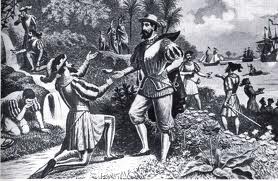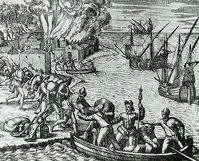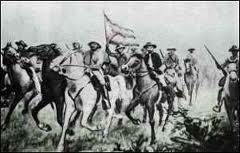|
Colonial Period
The colonial history of Cuba begins on 28 October 1492 when the Christopher Columbus and his crew set anchor in the bay of Bariay.

Originally Cuba was called 'Juana' by Columbus, named after the daughter of the Spanish catholic monarchs who had financed the westward voyage of discovery, but after a succession of names, the name Cuba, a shortened version of the original Taíno name, was adopted.
Columbus returned to Cuba 2 years later but it was not until 1511 that the Europeans started organizing permanent settlements in the country to the disgust of the natives.
Hatuey, a chief from the neighbouring island of Hispaniola (modern day Haiti and Dominican Republic) sailed to Cuba to warn the people of the brutality of the Spanish and the suffering that they had endured. When Diego Velásquez landed with his 300 men, they were greeted by tribal warfare.
The Spanish had Hatuey burned alive the following year and along with the European diseases which were systematically killing the Amerindians, the natives bowed down to the Spanish conquerors.
Small towns were set up, including Havana in 1514 and Santiago de Cuba in 1515. With little gold on the island the first settlers turned to agriculture using the Amerindians as slaves in the encomienda system - a Spaniard (the encomendero) would have a native family (or families) work for him as slave labour on his land in return for him teaching them about being Christian. Although not called slaves, the Amerindians were treated as such.
Within a period of half a century it is estimated that the number of natives reduced from around 100,000 to a mere 2000.

16th Century: Slaves and Pirates
The first black African slaves were brought to Cuba in 1513 from the neighbouring island of Hispaniola. In 1520, 300 more were brought in and by 1555 an estimated 700 slaves were working in the country.
During this time piracy was ripe and in 1538 French pirates burned down the city of Havana. In 1554, the French pirate, Francois (peg leg) Le Clerc took the city of Santiago de Cuba and occupied and devastating it for a month before moving on with 80,000 pesos. The following year another French pirate, Jacques de Sores, who had been a lieutenant under Peg leg Le Clerc, took Havana and burned it down again when he did not find the loot he was expecting.
17th Century to Independence
During the 17th century, pirates, horrendous weather in the form of hurricanes, illness, fighting and revolting slaves all made life difficult for the Spanish in Cuba.

At the turn of the century and estimated 20,000 people were living in Cuba, two thirds of which resided in the Havana area. In 1607 Havana became capital city of the country and by the end of the century, piracy had been outlawed (1697) and the population had more than doubled at 50,000 people.
In the early 1700's, tobacco and sugar cane production trade grew and the use of slaves for agriculture was never more important, particularly for sugar cane which by the middle of the century accounted for around 80% of the country's export trade and a third of the world's sugar. The number of slaves increased and there was also a major increase in the population. When the first census was made in 1774, the population was 171,620.
Slavery continued in Cuba in 1886, more than 20 years after the slave trade had officially ended.
The second part of the century saw many uprisings and revolts, none more so than the 10 year war which began in 1868. 1899 saw Spain relinquish control of Cuba which then came under protection from the United States until 1902 when the Republic of Cuba officially became an independent nation and so began a new era in the history of Cuba.
|